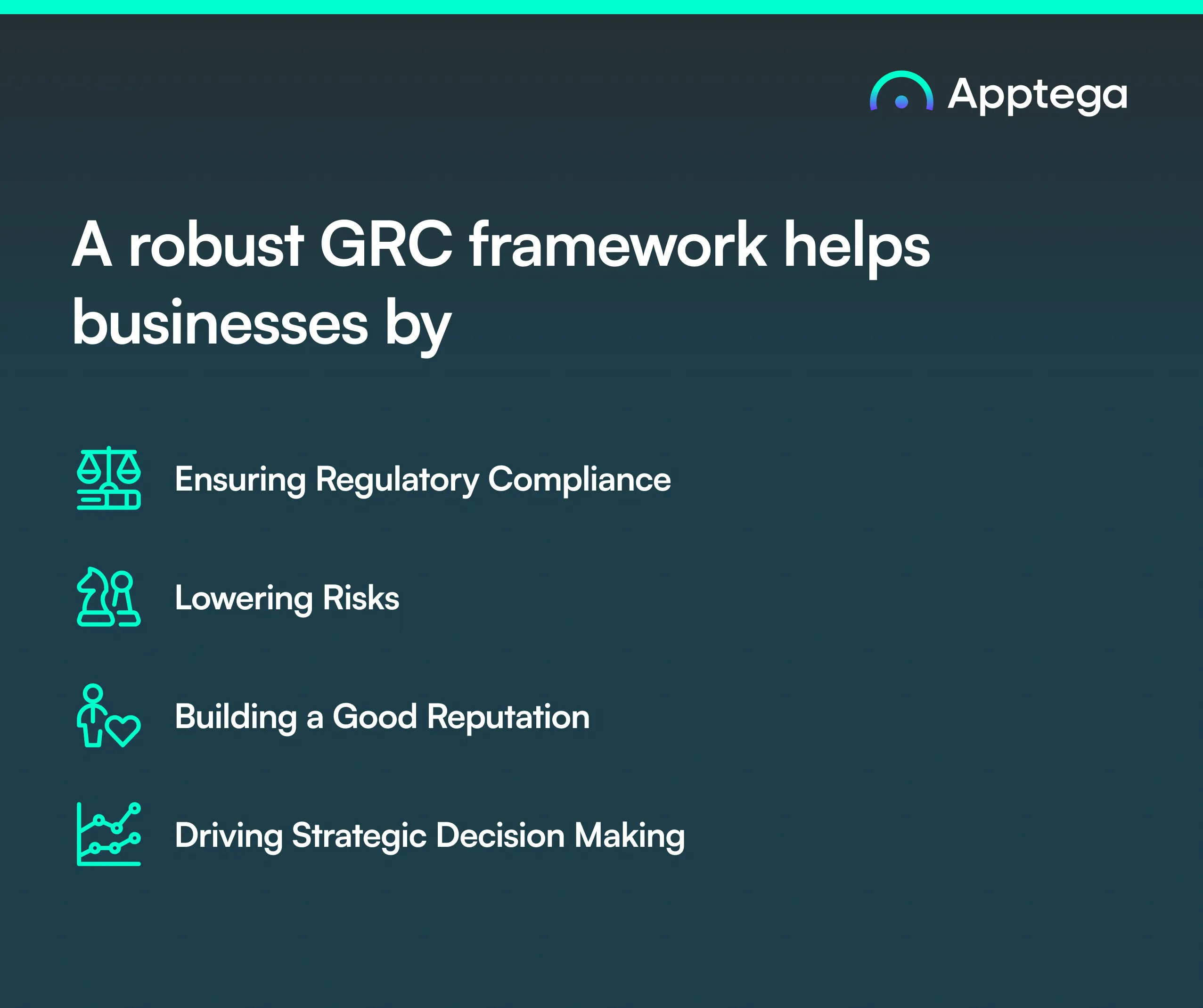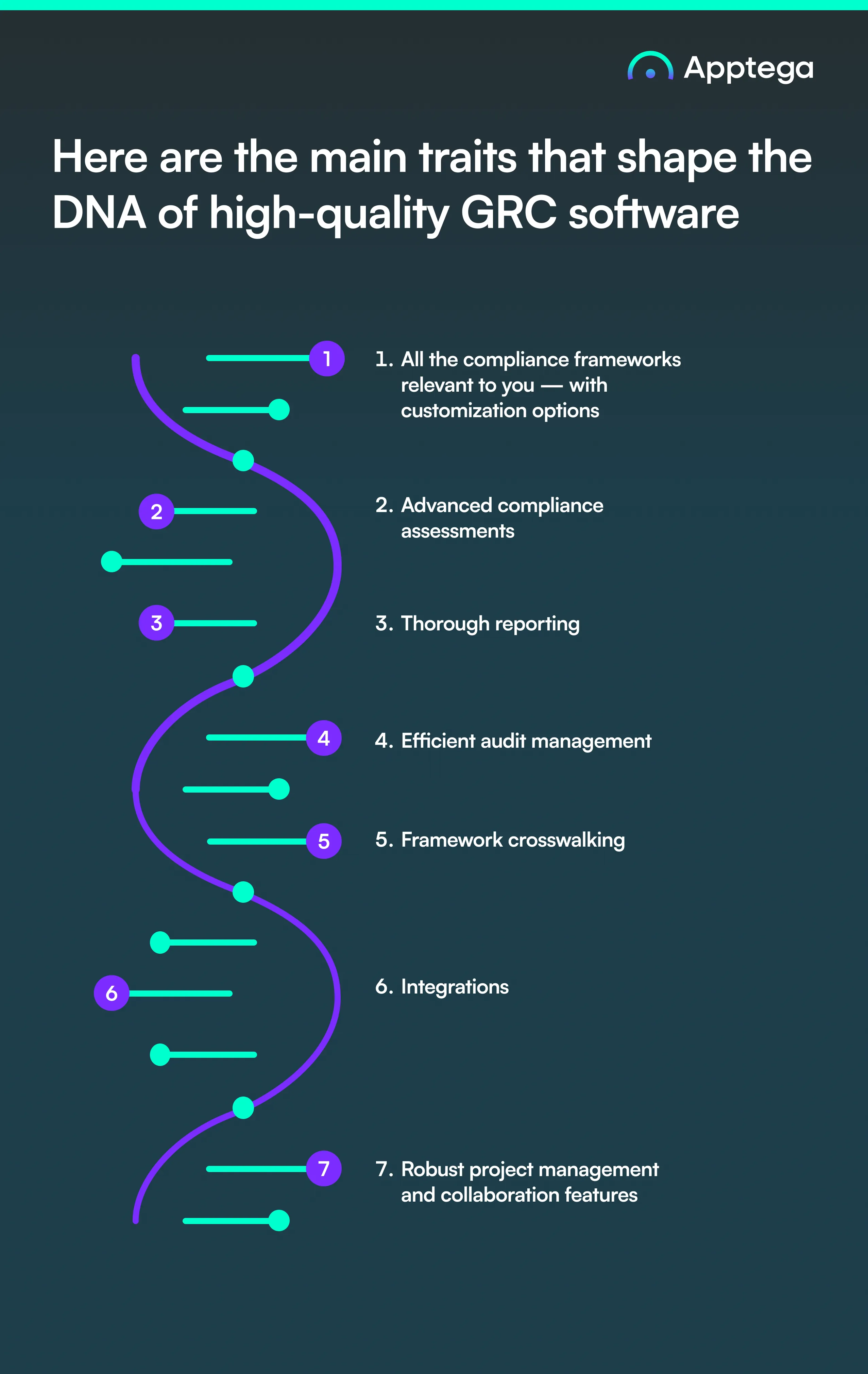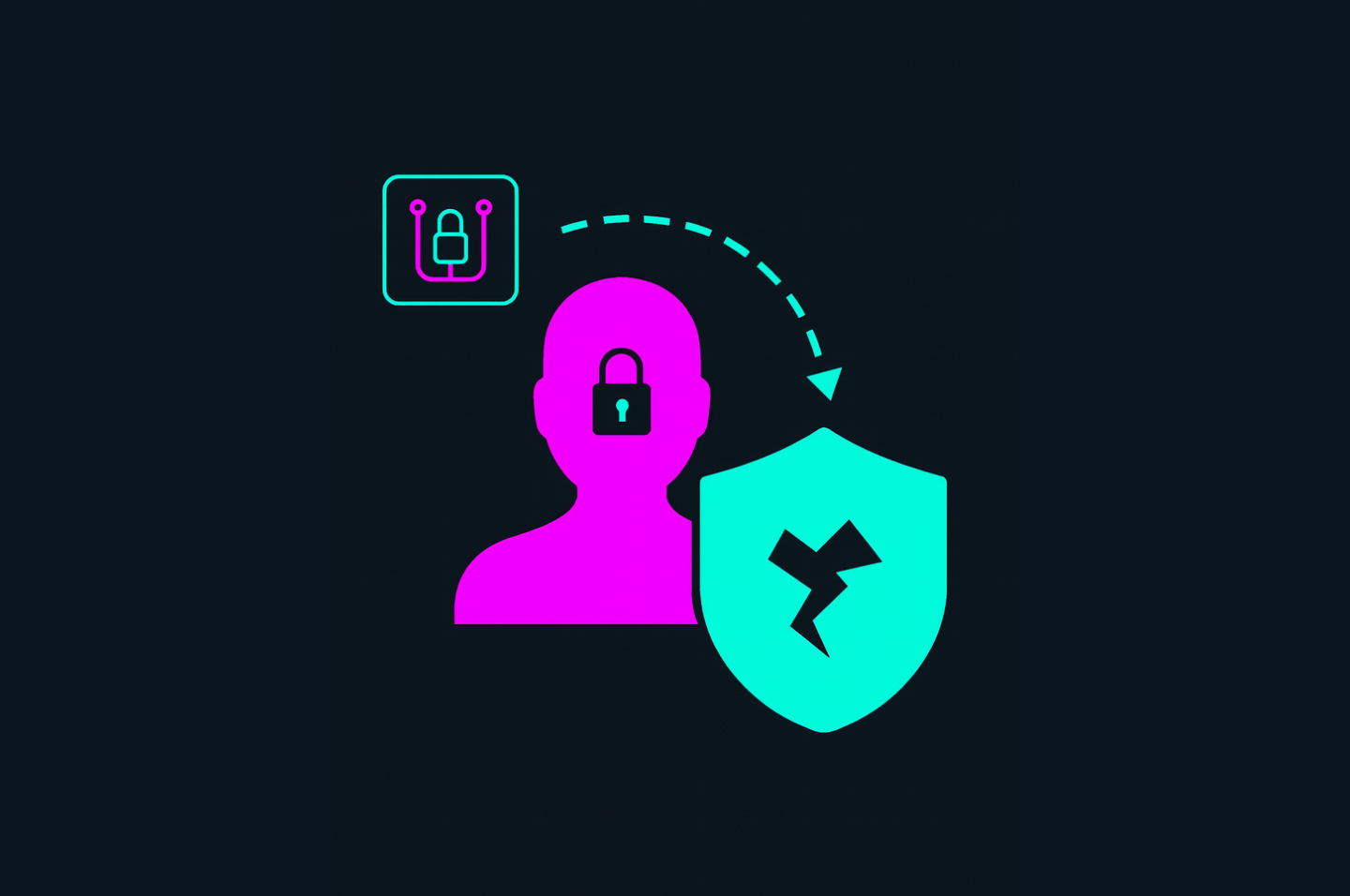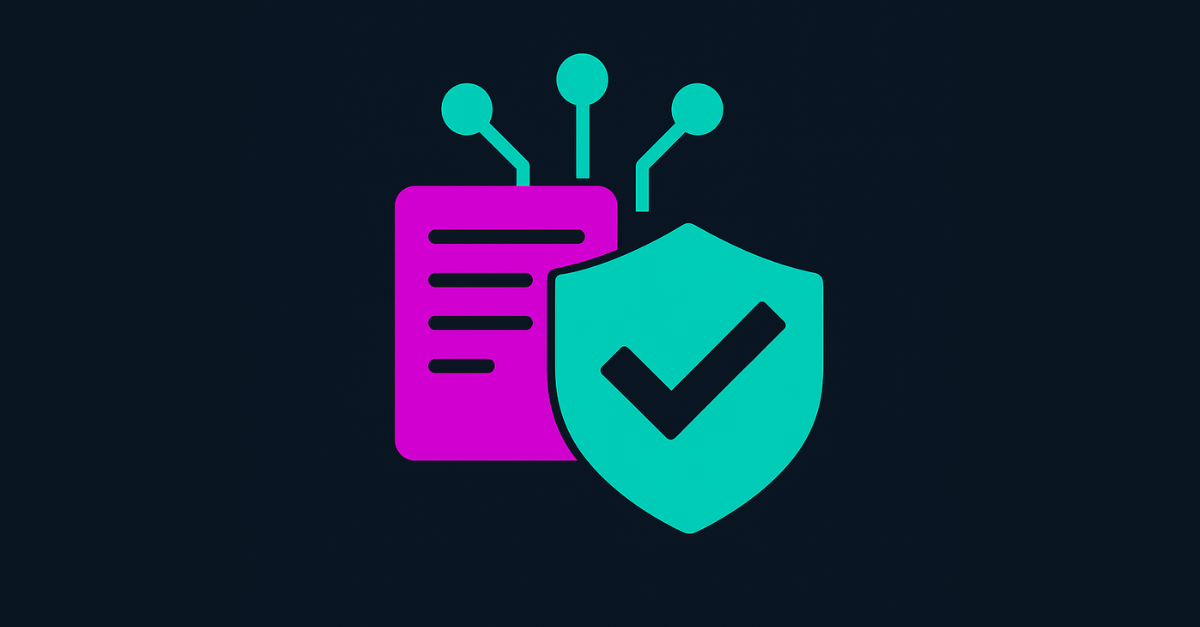What Is GRC Software?
Discover how GRC software streamlines managing GRC in today's complex business world, and how to select the right tool for you.

Increased regulatory scrutiny. Never-ending compliance requirements. A constant threat of reputational damage. New tech tools every four seconds. Growing demands from stakeholders. The list goes on…
Today’s business landscape is no joke. The complexity of modern corporate operations makes finding the most efficient and cost-effective way to manage governance, risk, and compliance (GRC) a must.
The development of GRC software marked a before-and-after moment in this realm, offering organizations and service providers a streamlined approach to navigating these vital aspects of business operations. By harmonizing governance policies, risk management strategies, and compliance requirements, this innovative type of tool emerged as a cornerstone for modern, resilient, and ethical business practices.
This guide is designed to cover all the key aspects of GRC software, its core functionalities, and the transformative impact it can have on businesses of all sizes and sectors.
More specifically, it goes over:
- The fundamentals of GRC, highlighting its importance in the modern business environment.
- A detailed explanation of GRC software, including its purpose and core functionalities.
- An overview of the significant benefits and improvements GRC software brings to an organization.
- Criteria and strategies for selecting the best GRC software for an organization's specific needs.
- Practical advice on implementing and utilizing GRC software for maximum efficiency and impact.
- A forward-looking perspective on the future developments and trends in GRC technology and its evolving role in business.
Whether you're a business leader, IT professional, or compliance officer, this guide will help you deepen your understanding of GRC tools and their role in achieving key organizational goals faster.
What is GRC and Why Does it Matter?
GRC — or Governance, Risk, and Compliance — is an integrated framework encompassing the strategies, processes, and technologies that ensure an organization's operations are ethically conducted, risks are effectively managed, and relevant regulatory requirements are met.
GRC should be seen as a holistic approach that integrates the three essential pillars for sustaining and propelling an organization forward:
- Governance refers to the rules, practices, and processes by which a company is directed and controlled. It focuses on establishing ethical leadership, enhancing organizational performance, and ensuring that the actions of the company align with its vision and values. Effective governance is key to maintaining trust among stakeholders and ensuring long-term viability.
- Risk Management involves identifying, assessing, and prioritizing risks, as well as developing strategies and resources to minimize and control the probability or impact of adverse events. Risk management is crucial for safeguarding an organization's assets, reputation, and stakeholder interests.
- Compliance is the process of adhering to regulations, standards, laws, and guidelines prescribed by industry bodies and governmental agencies and relevant to the business. It's not just about avoiding legal repercussions; compliance is about creating a culture that values ethical conduct and has a deep understanding of the regulatory landscape.
A robust GRC framework helps businesses by:
- Ensuring Regulatory Compliance: Staying up-to-date with the latest laws and regulations to avoid fines and legal issues.
- Lowering Risks: Identifying potential risks early and devising strategies to mitigate them.
- Building a Good Reputation: Establishing a company as reliable and ethical is vital for customer trust and fruitful business partnerships.
- Driving Strategic Decision Making: Providing a clear framework for decision-making that aligns with business goals and risk appetite.

What is GRC Software?
GRC software is a specialized technology designed to streamline and enhance the complex processes of Governance, Risk Management, and Compliance within an organization.
Using the right GRC software improves operational efficiency by consolidating various GRC-related activities into a single platform — significantly reducing the time and resources required for management and monitoring.
It greatly improves risk management capabilities, enabling proactive identification, assessment, and mitigation of potential risks with continuous monitoring. It also ensures consistent adherence to regulations, which helps companies create more business opportunities and avoid financial and reputational damage. Also, the increased visibility and accountability provided by the software strengthen internal controls and build stakeholder trust.
The key features of GRC software typically include:
- Risk Assessment Tools: For identifying, monitoring, and prioritizing risks.
- Compliance Management: To streamline adherence to laws and standards.
- Audit Management: To fast-track auditing processes.
- Reporting and Analytics: Providing insights for informed decision-making.
- Integrations: For connecting a company’s entire GRC ecosystem.
Your full GRC journey in one tool
Incinerate your spreadsheets. Apptega makes it dead simple to build, manage, and report your governance, risk, and compliance programs end-to-end.
How Does GRC Software Work?
There are different kinds of GRC software but the most effective tools are cloud-based platforms focusing on simplifying different aspects of governance, risk, and compliance processes. Its workflows are designed to be intuitive and user-friendly, allowing each business or security provider to build the GRC program that works best for their unique needs.
Here's an overview of how GRC software typically works:
- Framework Selection: Users begin by selecting from a library of industry-standard frameworks — ISO, NIST, CMMC, etc. — or creating a custom framework tailored to their organization’s needs.
- Initial Gap Assessment: With questionnaire-based assessments mapped to framework controls and integrations with data sources for quick evidence collection, running an assessment against any compliance framework usually takes a fraction of the time that it takes to go through that process manually or — God forbid — using Excel sheets. Plus, assessments come with automated tips for remediation that make the next step a breeze.
- Compliance Management and Reporting: You can get real-time visibility into compliance status against your programs and the selected frameworks. The GRC platform generates compliance reports and dashboards, making it easier for users to understand their compliance posture and take necessary actions.
- Risk Management: GRC software facilitates comprehensive risk assessments by allowing organizations to identify, analyze, and prioritize risks (both internal and vendor-associated risks). Users can create an entire program to manage these risks, set controls, and monitor progress in mitigating them.
- Audit Management: GRC software also generally streamlines the audit process by organizing audit-related tasks, storing evidence, and tracking audit progress. The platform simplifies gathering and presenting information required for both internal and external audits, ensuring compliance with various standards.
- Task and Project Management: GRC-related tasks and projects can be managed within this type of tool. You can automate the assignment of tasks, setting deadlines, and tracking progress, ensuring that all GRC activities are completed in a timely and efficient manner.
- Enhanced Collaboration and Communication: GRC software fosters collaboration across teams and external providers to ensure all stakeholders are on the same page regarding GRC initiatives.
GRC’s software workflow is centered around making every step of the GRC process efficient, from selecting and customizing frameworks and managing risks to ensuring ongoing compliance and facilitating team collaboration.

The Key Benefits of GRC Software
While GRC software offers numerous benefits to organizations that manage it internally — streamlining processes, reducing risk, and ensuring compliance — it’s also an essential tool for security providers who want to grow their recurring revenue by delivering their services through a tool that allows them to build valuable ongoing programs, opens internal bandwidth, and provides better visibility into the value they bring to the table.
Here are some the main benefits these tools bring for both in-house security teams and MSSPs.
Benefits of GRC Software for MSSPs
- As an MSSP, using the right GRC software can help you develop a fully formed recurring compliance solution by layering your cybersecurity services on top of state-of-the-art technology. Your compliance offering becomes much more attractive and easy to showcase when you have a tool that maps to each of your services, makes every process more efficient, and provides customers full visibility into their cybersecurity posture and the progress of the programs you’re running for them.
- By powering your services with GRC software, you can also grow annual recurring revenue as you are better positioned to offer ongoing compliance services that increase customer retention.
- At the same time, GRC software would allow you to open internal bandwidth to serve even more clients thanks to the efficiencies created by managing all your customers’ programs end-to-end via a streamlined cloud-based platform.
Benefits of GRC Software for In-House Security Teams
- For in-house security and compliance teams with the capacity to operate a GRC tool internally, the main benefit is that you can greatly accelerate the time it takes to achieve compliance with relevant frameworks as manual work is no longer necessary. Apart from time savings on compliance, you can also streamline risk management and audit prep without involving external resources to help you with those processes.
- The right GRC software will also help you identify and manage risks more effectively, which is proven to lead to revenue and profit growth. An enhanced risk management process also allows you to reduce your insurance burden.
- Automating GRC processes can also lead to significant cost savings, especially by avoiding penalties associated with non-compliance and by being able to self-manage their GRC programs without the need for external resources.
GRC software also provides valuable insights that aid in strategic planning. Companies with integrated GRC strategies are more capable of aligning their risk management with business goals, leading to better decision-making.
The DNA of Top-Notch GRC Software
As we’ll explore more in-depth in the following section, there’s no one-size-fits-all solution when it comes to GRC software. Each organization or service provider can benefit from a different type of technology based on their unique needs and existing cybersecurity compliance tech ecosystem.
However, certain must-have capabilities in GRC software can make or break its effectiveness regardless of the specific requirements of the end user.
Here are the main traits that shape the DNA of high-quality GRC software:
- All the compliance frameworks relevant to you — with customization options: As your business or customer business grows and evolves, having the ability to adapt and tailor to various industry standards and regulations is crucial. This includes customizable templates and tools for different compliance frameworks.
- Advanced compliance assessments: The tool should facilitate compliance assessment for all the listed frameworks by covering all controls and sub-controls in-depth, allowing you to easily answer questionnaires and provide supporting evidence.
Ideally, you want a tool that also provides automatic remediation suggestions after it identifies key gaps and allows you to easily transfer the results and data from your initial assessment to an audit-ready compliance program.
- Thorough reporting: Look for a technology that provides real-time insights into compliance status, with capabilities for generating detailed reports and compliance dashboards.
- Efficient audit management: Best-in-class GRC software offers a streamlined path from assessments to audits. Plus, it has strong capabilities to manage audit-related tasks and store evidence.
- Framework crosswalking: The capability to harmonize different compliance frameworks is particularly useful for companies that need to comply with various regulatory requirements with shared control families, which is something that will inevitably happen as a company scales.
- Integrations: When you’re able to connect your entire cybersecurity ecosystem and exchange data across different platforms, the effectiveness and time-savings brought by GRC software grow exponentially.
- Robust project management and collaboration features: Look for tools that allow you to assign, track, and manage GRC-related tasks and projects so your entire team can work in a collaborative environment and stay aligned.
In conclusion, the best GRC software is a comprehensive, adaptable, and user-friendly tool that addresses all aspects of governance, risk management, and compliance in the way that works best for its users.

How to Find the Right GRC Software for You
Now that you’re familiar with the qualities of top GRC software, you’re better positioned to start thinking about your own needs and requirements to choose the best tool for you.
A good way to lay out those requirements and evaluate the different options in the market is by asking yourself the following questions. You can even assign a different weight to each of them (1-5 score, for example) depending on their relevance to be able to rate each of the tools you evaluate.
- What are our key governance, risk management, and compliance challenges? Identify the specific GRC issues your organization faces and look for solutions that best tackle them.
- What level of customization will you need? Assess if the software can adapt to your industry's unique standards and compliance requirements, as well as to your existing processes and workflows.
- What integration capabilities are necessary for your existing systems? Determine how well the software can integrate with your current tech stack and infrastructure.
- What is your budget and expected ROI for the software? Balance the cost against the expected benefits and improvements the software will bring.
Once you have a weighed answer to each of those questions, you may consider this method to vet the different GRC solutions you explore:
- Research and shortlist: Conduct research to identify GRC tools that appear to meet your needs. Shortlist the ones that align closely with your requirements and assign that 1-5 score mentioned above.
- Request demos and/or trials: Reach out to vendors for demonstrations tailored to your needs and, if possible, arrange trial periods to test the software by yourself.
- Check vendor support: Assess the level of customer support provided by the vendor and their onboarding/support materials to ensure you’re always covered.
- Gather feedback: Involve the teams who will be using the software in the evaluation process. Their insights can be crucial in understanding the practical utility of the tool.
- Consolidate scores and feedback: Finally, consolidate the scores and feedback for each software to compare and make an informed decision.
In case you’re evaluating Apptega as your GRC solution, your assessment will be fairly simple as it offers both customized demos and a 14-day free trial, as well as a world-class team of cybersecurity compliance professionals who are always a click away to assist you with any question you may have and will work with you throughout your entire journey using the platform.
In addition, with 30+ frameworks, automated gap assessments, a robust risk manager, a powerful audit manager to pass audits in days rather than months, powerful integrations to connect all your data sources, and the ability to crosswalk different frameworks with a click, it has all the features you need to successfully manage and bring visibility to all your GRC initiatives.
So whether you’re an MSSP trying to grow your business by offering an attractive compliance-as-a-service offering or an in-house security team looking to manage GRC initiatives more efficiently, Apptega is a great and cost-effective option for you.
Mastering the Tool: How to Successfully Implement and Use GRC Software?
Even the best GRC software won’t bring any benefit to your organization unless it’s implemented correctly. A solid implementation plan includes a clear timeline, key milestones, thorough staff training, and a plan to mitigate potential challenges and manage change during the rollout. Engaging stakeholders from various departments early in the process is also crucial for a smooth transition and to ensure everyone understands, trusts, and accepts the new tool.
Training is one of the most relevant elements of this plan. Employees must understand not only how to use the software but also its significance in the larger context of the organization's GRC strategy — or, if you’re an MSSP implementing a new GRC tool to support clients, all relevant team members need to understand how your services are blended into the technology. Comprehensive training sessions, combined with accessible support materials, can do wonders to increase user competency and confidence.
Integration into existing systems and workflows is essential. The software should complement and enhance your current processes, not complicate them. This may involve customizing certain features of the software to fit your operational framework. Also, make sure the software is integrated with your existing tech stack to accelerate processes like evidence collection, risk monitoring, reporting, etc. This will make it 10X more valuable and hard to ignore by those employees who might be more resistant or skeptical.
Finally, continuous monitoring and a willingness to iterate are key. Ask for feedback regularly from users, analyze software performance, and make necessary adjustments that will keep the software relevant and effective over time. Your vendor should be a great ally here, as well as a valuable resource along the entire implementation process.
Adopting these strategies will not only ensure an effective implementation process but also guarantee that your new GRC software becomes an integral and effective part of your organization's risk management and compliance efforts or services.
The Future of GRC Technology
As is the case with virtually any other technology today, one of the key trends in GRC software is the growing integration of artificial intelligence. AI’s promise to revolutionize GRC programs is focused on providing better predictive analytics, which can foresee potential risks and compliance issues; improve fraud detection through pattern recognition; make data management more efficient; and enhance decision-making by providing insights and recommendations based on real-time data analysis.
One of the key challenges for GRC technology is the rapid evolution of digital threats. That’s why GRC software must be constantly updated to protect you against these risks and be able to stay one step ahead of cybercriminals. We’ll likely see applications of AI to predict the next cyber threat and allow you to have a more proactive approach to cybersecurity.
Cloud-based GRC solutions like Apptega are gaining traction due to their scalability and ease of access. This shift will allow organizations of all sizes to implement sophisticated GRC tools without the need for extensive infrastructure.
As regulations keep evolving and new compliance frameworks emerge, GRC technology will need to adapt accordingly to allow users to stay compliant at all times.
User experience will also be a key focus area. GRC tools are becoming more and more intuitive and mobile-friendly, which makes them accessible to a broader audience.
Additionally, the connection of GRC tools with other systems will become broader and more seamless. This integration will allow for better data sharing and decision-making, ensuring that GRC management is more closely aligned with overall business strategies.
In conclusion, the future of GRC technology is set to be more powerful, integrated, and user-centric. Keep this future vision in mind when choosing the right GRC software for you — along with all the requirements previously discussed — and you’ll have a strong and efficient GRC practice for years to come.
Ready to get started?
Request a no-risk 14-day free trial to see how you can create a sticky compliance-as-a-service offering with Apptega.
.svg)






